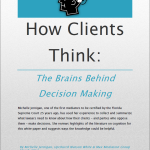 "How Clients Think: The Brains Behind Decision Making": Click the photo to download the white paper.
"How Clients Think: The Brains Behind Decision Making": Click the photo to download the white paper.
This series of blog posts about how clients make decisions may help in guiding a client before, during and after a mediation.
Some of the peculiarities of decision making can be explained at least in part by neuroscience, which had its roots not so much in the observation of everyday decision making, but in the observation of aberrant behavior.
Neuroscience is defined as a branch of the life sciences that deals with the anatomy, physiology, biochemistry, or molecular biology of nerves and nervous tissue and especially with their relation to behavior and learning. It began in 1848 as a result of a terrible work-related accident suffered by railroad construction foreman Phineas Gage. Gage had a metal rod stuck in his skull, yet survived. Post-accident he was a completely different person – rude, vulgar, and socially inappropriate.
Scientists studying Gage determined that there was a correlation between the damaged areas of his brain and his altered behavior.
Now, we can explore the cognitive biases that have been well established by research in the field of behavioral psychology since Gage's time, delving into the discipline of neuroscience and looking into the effects of intuition, emotion, and mood on decision making. We then will examine left- and right-brain functions and the differences in how the two hemispheres process information. Finally, we will offer strategies or interventions to help you and your clients engage in better decision making.
Next: About cognitive biases. To download Michelle Jernigan's white paper, from which this blog series is excerpted, click here.
Previous Article